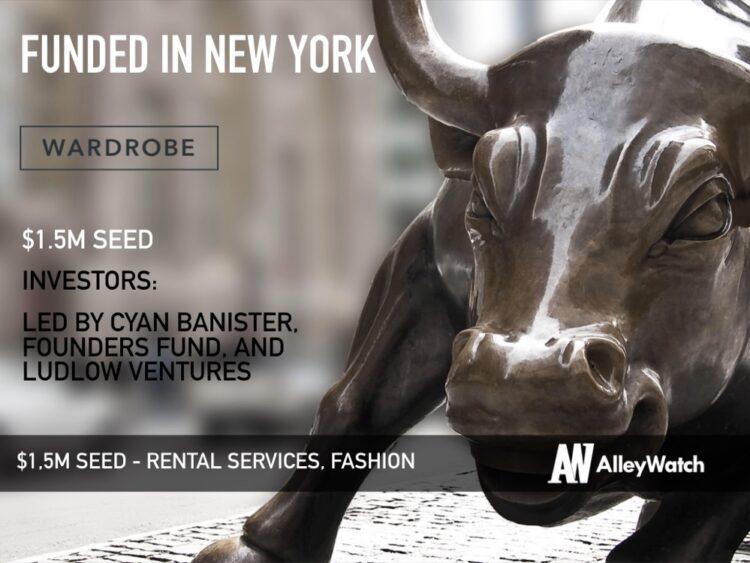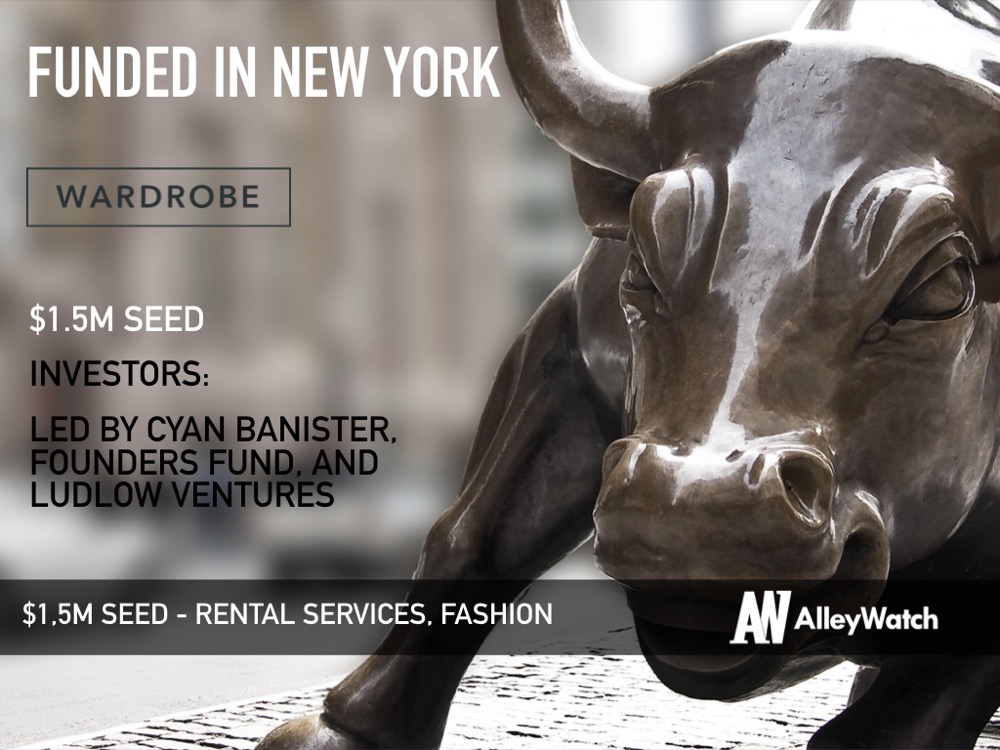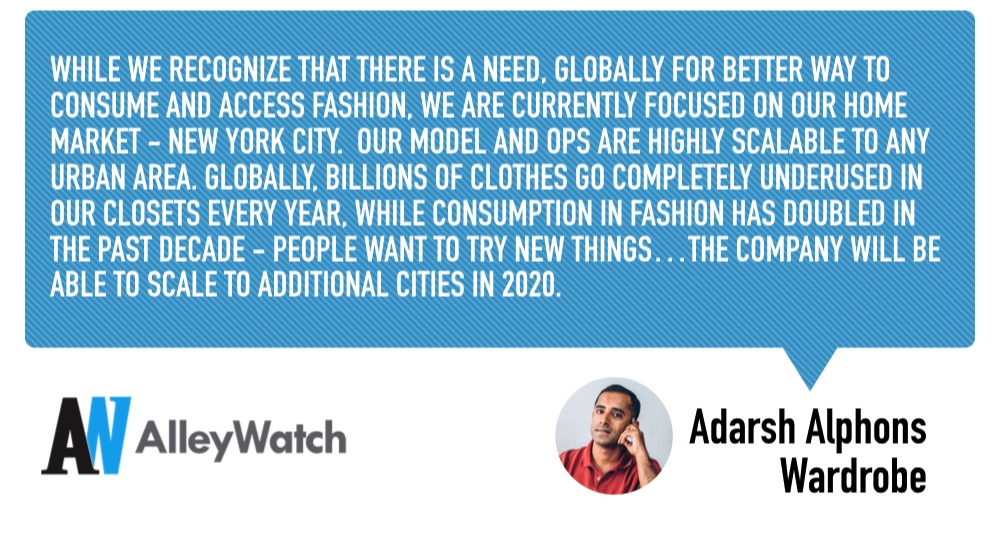Remember sneaking into an older sibling or your parents’ closet and browsing through which shirt you planned on “borrowing”. This unofficial method of borrowing is being completely reinvented with the latest peer-to-peer fashion platform Wardrobe. Since people only wear 20% of their wardrobe regularly, this platform creates a new revenue stream by allowing people to rent out luxury, designer and vintage clothing at an accessible price point. To make rentals seamless, Wardrobe partners with local dry cleaners to provide cleaning, storage, and the critical point of pickup. This strategic partnership reduces significant, overhead expenses and Wardrobe charges a small fee per rental.
AlleyWatch sat down with Adarsh Alphons about entering the fashion industry and tapping into the power of the circular economy.
Who were your investors and how much did you raise?
The oversubscribed $1.5M Seed was led by Cyan Banister, angel investor and Partner, Founders Fund, and Ludlow Ventures with additional participation from 16 others including founders of Airbnb, Coinbase, Opendoor, Vine and HQ Trivia, strategist and VC’s such as Ground Up Ventures, Shrug Capital, MGV, Secocha Ventures amongst others.
Tell us about the product or service that Wardrobe offers.
Wardrobe is a peer-to-peer platform that enables people to rent luxury, designer and vintage clothing from each other’s closets at affordable prices. Wardrobe partners with local dry cleaners to turn them into fashion hubs that provide the cleaning, storage and serves as neighborhood access points where users can pick-up/ return their rented items.
 What inspired you to start Wardrobe?
What inspired you to start Wardrobe?
I first had the idea of Wardrobe while attending a wedding in India. While admiring the elaborate outfits of fellow guests, I was reminded of how many of my own clothes at home remained untouched or worn only a handful of times. In a world where millions of strangers stay in each other’s houses globally (Airbnb), I wondered if it would be possible to normalize a world in which we borrowed clothes from strangers in lieu of constantly spending money on new wear. We only wear 20% of our wardrobe regularly. In the UK alone, 3.6 billion clothes were left unworn last year. US has 5X the population of UK. I have always been interested in the sharing economy and re-purposing underutilized assets. Prior to Wardrobe, I founded ProjectArt, now the nation’s largest art school, without owning a single building (50+ locations across 8 cities). We did this by tapping into underutilized space in public libraries and turning them into our schools. To normalize a clothes-borrowing on scale, we would have to make the experience seamless, predictable and repeatable. It immediately occurred to me that this marketplace would be all about execution.
How is Wardrobe different?
Wardrobe is the most seamless peer fashion rental marketplace ever to be built. Unlike other platforms that often have large overhead expenses, such as inventory, warehousing, and shipping – or just entirely leave the cleaning and shipping logistics to its users, Wardrobe partners with local dry-cleaners to make rentals frictionless. It’s a win-win partnership. We take care of cleaning, warehousing, logistics, delivery, and photography to make sure renters and lenders can seamlessly interact in the circular fashion economy! Moreover, we’re all about actual people – we let users literally connect with others over closets. There is a unique social component that’s very strong on the platform that is built entirely based on user recommendations.
Who do you consider to be your primary competitors?
Technically we’re so different from anything out there that it would be unfair to call us or others competitors. The closest competitors would be other fashion rental companies. However, there are two main differences: on the ops side, we’re a three-sided marketplace (dry-cleaners) and on the user side, the marketplace highly social because we’re structured around real people and their closets.
What market does Wardrobe target and how big is it?
While we recognize that there is a need, globally for better ways to consume and access fashion, we are currently focused on our home market – New York City. Our model and ops are highly scalable to any urban area. Globally, billions of clothes go completely underused in our closets every year, while consumption in fashion has doubled in the past decade – people want to try new things. Our goal is to address both these realities with one managed, seamless marketplace. With our recent funding, strategy and traction from this fall, the company will be able to scale to additional cities in 2020.
What’s your business model?
It’s very simple – Wardrobe takes a small fee for every rental that takes place on the platform. The fee ensures the seamless experience: safety of the items (insurance), photography, cleaning, storage, delivery, customer service and to keep our servers running.
What was the funding process like?
Very different than what I expected it to be! Going in, I knew zero VC’s! I knew right away that I needed to seek advice and mentoring, so I reached out to a few individuals I admired in the startup space and was extremely lucky to get their time. The process was definitely about relationship building, communication and of course traction. Once our early traction started to look promising, we were able to get the attention of Cyan Banister (whom I admire so profoundly), who became our Co-Lead and then the round came together fairly right after that.
What are the biggest challenges that you faced while raising capital?
It always seems so hard when you’re in it and not making much progress. I would say the biggest challenge was hearing feedback from VC’s who couldn’t imagine a reality in which a startup such as ours could take on companies like Rent the Runway.
What factors about your business led your investors to write the check?
No one at Wardrobe is a fashion insider. What we’re good at is understanding the user and creating a product around them. We’re really big on data and data science. From day one, we’ve been keeping a close watch on traction and signals of Product-Market-Fit and have been iterating our product based on that. There are two principal reasons why I believe we were able to build conviction in our investors: Operational efficiency (dry-cleaners as fulfillment centers) and solid early traction.
No one at Wardrobe is a fashion insider. What we’re good at is understanding the user and creating a product around them. We’re really big on data and data science. From day one, we’ve been keeping a close watch on traction and signals of Product-Market-Fit and have been iterating our product based on that.
What are the milestones you plan to achieve in the next six months?
We have a clear set of KPIs and OKRs we’re measuring against. We’d like to see a certain amount of product adoption in the NYC market. Other key metrics include engagement and customer retention. The product is nowhere near perfection – we believe this is just the first chapter and we look forward to learning and iterating a ton in the next six months. That said, if we are able to measure up to a few key target internal metrics, it would be indicative of our future direction.
What advice can you offer companies in New York that do not have a fresh injection of capital in the bank?
Don’t run out of money! Build as if you will not be getting any funding. Listen/ talk to your customers (users) all the time. Stay close to them and try to understand how you can solve their problem. Measure key metrics from the on-set. Build based on the data you see and signals of PMF. Then, when you pitch, make sure the investor gets to know the story, the vision, and the traction.
Where do you see the company going now over the near term?
This fall-winter, we’re completely focused on product adoption, providing consistent operations and letting the data tell us what to do next. We’re going to stay super dialed-in with our users to give them the best possible experience on a fashion platform.
Where is your favorite fall destination in the city?
This one’s easy: a Wardorbe Hub (dry-cleaner)!





